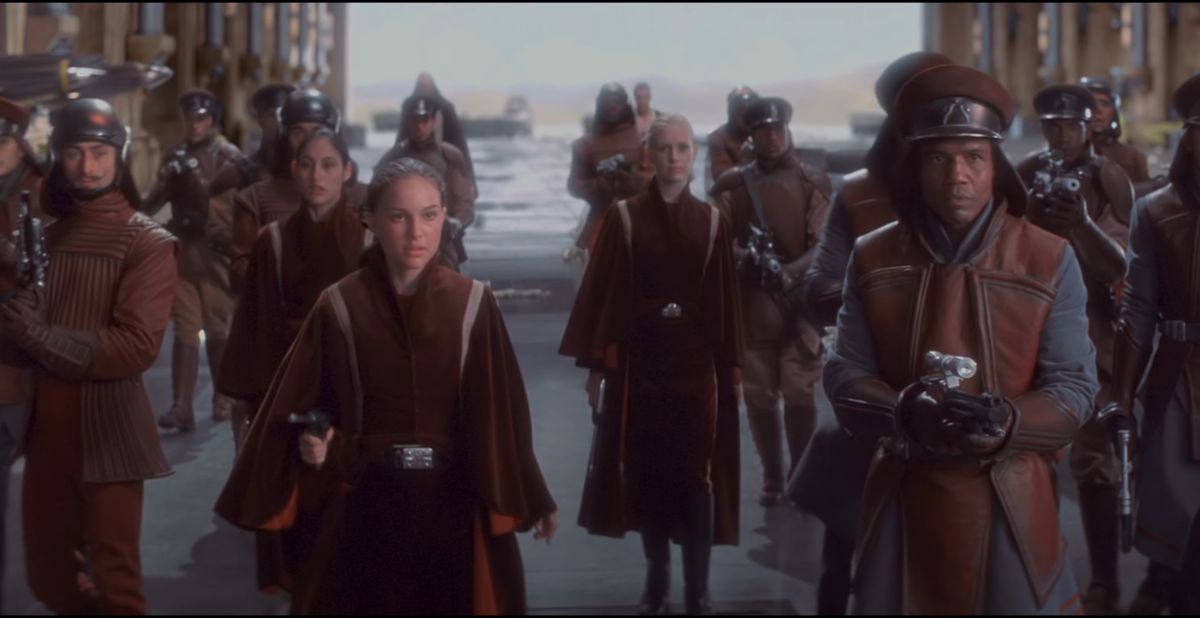By the time we reach the final duel in The Phantom Menace, Maul’s objective is clear. He was sent to Naboo to capture Queen Padmé Amidala and force her to sign a treaty that would legitimize the Trade Federation’s invasion.
Padmé, backed by Naboo security and the Jedi, fights back. When the group enters the hangar, Maul appears, and we see Qui-Gon and Obi-Wan step forward while at least 18 armed Naboo guards stand behind them.
But instead of taking on Maul together, Qui-Gon tells the guards to fall back. He decides to face the Sith alone, with only Obi-Wan by his side.
Why turn down help in a fight this dangerous? Could extra firepower have changed the outcome—or even saved Qui-Gon’s life?
The Priority Was Saving the Queen and Recapturing the Capital
The first thing we have to mention is that the Trade Federation had already taken the capital city of Theed. At the time of the hangar scene in The Phantom Menace, the priority wasn’t dueling Darth Maul — it was reaching the throne room, capturing Nute Gunray, and ending the occupation of Naboo.
That’s why Qui-Gon told the Naboo guards to press forward. If they had stopped to help him fight, the mission to retake the capital could’ve failed. The longer they were delayed, the more likely it was that the Federation would regroup, reinforce the palace, or escape entirely.
So when Darth Maul appears in their path, Qui-Gon immediately understands what’s at stake. Yes, Maul is dangerous. Yes, he’s there to kill them. But stopping the entire group to take him on would’ve been a tactical disaster. Every second mattered. The longer they were delayed, the higher the chance that Gunray could escape or that reinforcements could secure the palace again.
Qui-Gon Knew the Naboo Guards Would Just Get in the Way
Another factor we have to consider is that the Naboo guards likely wouldn’t have stood a chance against Darth Maul—and worse, they might’ve just gotten in the way. As a Jedi Master, Qui-Gon understood that blasters wouldn’t do much against someone like Maul. After their first duel on Tatooine, Qui-Gon already knew just how fast, aggressive, and dangerous Maul was.
At this point in the story, Qui-Gon was the only Jedi with firsthand experience fighting him. And Maul wasn’t just some rogue Force user—he was a Sith Lord. That meant it didn’t matter if 18 or even 100 guards pointed blasters at him. Maul would deflect every shot and likely turn it back on them. If the guards got killed trying to help, that would leave Padmé with even fewer soldiers protecting her. Her safety would be compromised, and the entire mission to take back Naboo could fall apart.
If the Guards Died, Padmé Was as Good as Captured
If the guards had stayed to fight and fallen, the consequences would’ve been catastrophic. Padmé’s capture wouldn’t have just been a personal loss, it would’ve shattered the entire mission. She was more than just a political figure; she was the rallying point for the entire Naboo resistance. If Maul had broken past the Jedi and seized her, the Trade Federation would’ve had exactly what they needed: a way to legitimize their occupation through a forced treaty.
With no queen, no leadership, and no clear path forward, the Naboo forces would’ve been thrown into chaos. Morale would’ve collapsed. The Jedi would’ve been forced into a desperate rescue attempt instead of retaking the capital. The mission would’ve shifted from offensive to reactive, and that kind of delay is exactly what the Federation needed to regain control and crush any hope of rebellion.

